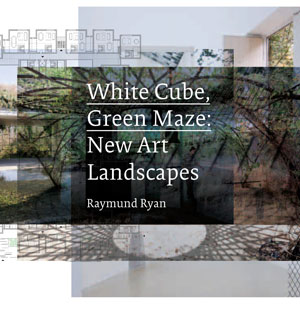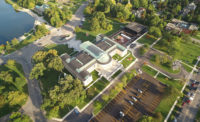University of California Press, 2012, 120 pages, $40.
In recent decades, hundreds of new museums have sprung up in emerging art markets across the globe. In most of them, art remains confined to sterile, “white cube” galleries, while architecture and nature remain, quite literally, outside. A very different model, though, was pioneered more than 50 years ago by projects such as the Louisiana Museum of Modern Art in Denmark, which showed how art, architecture, and landscape could be brought together. In White Cube, Green Mazes: New Art Landscapes, Raymund Ryan, curator of the Heinz Architectural Center at the Carnegie Museum of Art, advocates for this type of museum—a museum “liberated into fragments,” a multi-site, pavilion-based model he terms the “Green Maze.”

Written in tandem with an eponymous exhibition—which started at the Heinz Center in 2012, then traveled to the Yale School of Architecture in 2013—the book examines six case studies through the lens of photographer Iwan Baan. Some of these institutions radically alter post-industrial brownfields, while others take advantage of native, ecological surroundings.
Take for instance, the Benesse Art Site on Naoshima Island in Japan, a former industrial region transformed by Tadao Ando (and a few other architects) into a multipart museum. The design enables visitors to meander through and around a series of buildings, pavilions, and installations to encounter artwork in unexpected locales: a photograph by Hiroshi Sugimoto perched on boulders, a sculpture by Yayoi Kusama resting near a ferry terminal. Or, the Instituto Inhotim, a sprawling nature reserve in Minas Gerais, Brazil, originally landscaped by Roberto Burle Marx, where lush, indigenous flora frame nearly two dozen pavilions and works by artists including Rirkrit Tiravanija and Doug Aitken. The book also explores Olympic Sculpture Park in Seattle designed by Weiss/Manfredi, Jardín Botánico de Culiacán in Mexico by Tatiana Bilbao, Siftung Insel Hombroich in Germany by Erwin Heerich, and the soon-to-be Grand Traiano Art Complex in Italy by Johnston Marklee and HHF architects.
In a sense, White Cube, Green Maze is a sanded-down version of the cross Brian O’Doherty (who contributes an introductory essay) took up in the mid-1970s— a thorny polemic against the White Cube-style gallery. But Ryan not only proposes a move away from traditional curation, but a move toward a more democratic museum typology, a model in which architecture, art, and nature hold equal clout in an aesthetic experience. The viewer is encouraged to roam and discover in the Green Maze. And for the museums of the future, a new form may lie at the end of these labyrinths.





Post a comment to this article
Report Abusive Comment